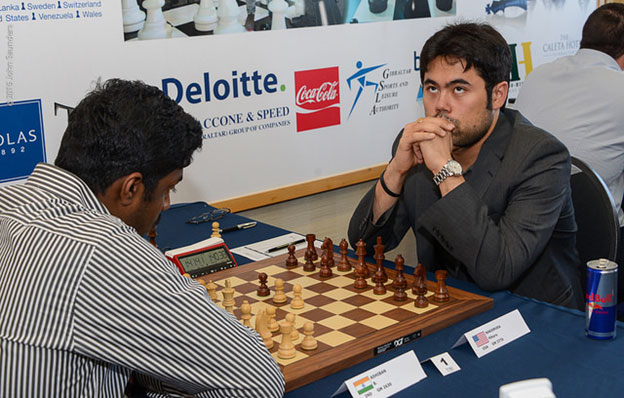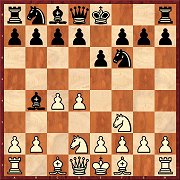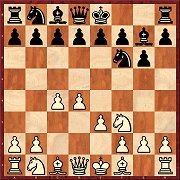ChessBase Magazine 164 – A day well spent!
 Review by Sagar Shah
Review by Sagar Shah
One problem that a chess player faces when he trains is the following question: “On what phase of the game should I concentrate? Opening, middlegame or the endgame.” It happens quite often that we have worked really hard on the openings and feel confident going into a tournament. Sure enough, we get winning positions, but our technique is completely lacking. Something similar could happen with players who dedicate all their time to tactics and endgames. They are unable to get favourable positions out of the openings. Hence, on 1st of February 2015, when I sat down to work, I decided to give equal importance to all the three phases of the game. The latest issue of ChessBase Magazine, CBM 164, had just been released. I decided to work with complete dedication on everything that was given in it! Here are my findings.
World Championship 2014
To tell you the truth, I was saturated with the World Championship reporting. I followed each and every game very closely and there was nothing much left to be known in those eleven games, at least not after more than two months of the match being over. Yet there were certain things which made me go over the World Championship material presented in the magazine. Firstly CBM got its best annotators to analyze the games. They included Mihail Marin, Parimarjan Negi, Evgenvy Postny, Michael Krasenkow and Rustam Kasimdzhanov. And secondly they were able to get the views of the seconds, Radoslav Wojtaszek and Peter Heine Nielsen, on games five and eleven respectively.

Wojtaszek and Nielsen: the analysis of seconds are always captivating
because you are able to get the inside information
I must say that I found Nielsen’s analysis not so interesting because he annotated the game from the point of view of a neutral analyst rather than Carlsen’s second. But Wojtaszek was more forthcoming and revealed quite a lot of information about Anand’s preparation, why he chose the particular line and until what point was it worked out at home.

Mihail Marin covers the openings of few of the World Championship games in his video…

….but what was really fascinating was his comparing of the games played in the
World Championship match with some other classical games in which similar plans were used.
Lastly, I really liked what the editor of CBM, Rainer Knaak, had to say about the double blunder of 26.Kd2?? and 26…a4?? that happened in the sixth game of the match. He shows the following position:

Carlsen-Karjakin, Sao Paulo 2012, Black to play
Carlsen just played 46.Rd3-d5. Black can now strike with the very surprising 46…Rxb2!! 47.Nxb2 fxe4 and the rook on d5 is trapped. Instead Karjakin continued with 46…Rd8 and with great difficulties managed to draw the game. Knaak’s explanation of Carlsen’s mistakes going unpunished is very insightful:
“Why Carlsen makes such mistakes is one question. He is only human after all, is the obvious answer. But why are the mistakes not punished on the spot? I believe that Karjakin (or Anand) would have exploited the opportunity against almost any other player. With any weaker opponent one is really expecting mistakes, because that is how one gets the chance not only to save a game, but even to win it. Against a stronger opponent everyone is simply dreaming of a draw and thus it is easy to miss such opportunities.”
Qatar Masters 2014
The Qatar Masters 2014 was one of the strongest open tournaments to be ever held. Vladimir Kramnik played in an open tournament after a gap of nearly twenty years! The Chinese Yu Yangyi won it surprisingly, ahead of many big names like Anish Giri, Vladimir Kramnik, Shakhriyar Mamedyarov, MVL etc. The coverage of this tournament in CBM is excellent.

CBM was able to get Yu Yangyi to annotate his two key clashes. One was against Anish Giri in the penultimate round and the other was with Vladimir Kramnik in the last round. (picture by Maria Emelianova)
It is always wonderful to read the winner’s comments. I was impressed with the annotations of this young Chinese player. He gave a perfect balance of words and variations. The reader gets to know what was going through his mind when he made a specific move. Below is an extract of his analysis of the game against Kramnik. Of course I could not reproduce all of the annotations here, but this 10% of the comments will give you an idea of Yu Yangyi’s excellent ability to explain.

[Event "Qatar Masters op"] [Site "Doha"] [Date "2014.12.04"] [Round "9"] [White "Yu, Yangyi"] [Black "Kramnik, Vladimir"] [Result "1-0"] [ECO "C65"] [WhiteElo "2705"] [BlackElo "2760"] [Annotator "Yu Yangyi"] [PlyCount "65"] [EventDate "2014.11.26"] [EventRounds "9"] [EventCountry "QAT"] [Source "ChessBase"] [SourceDate "2015.01.15"] {Before the final round Kramnik, the second seed in this tournament (behind Giri), was leading the field with 7.0/8, followed by me with 6.5/8. I felt a bit exhausted after my lucky but deserved five hour victory in round eight against Giri. Playing the former World Champion, whose games I had studied extensively ever since I began playing chess, was of course a great event for me. I approached the last round with excitement and was eager to learn from one of the most renowned personalities in chess history.} 1. e4 e5 2. Nf3 Nc6 3. Bb5 Nf6 {Not a big surprise - I was expecting either the Berlin or the Petroff.} 4. d3 {I chose a line that avoids the exchange of too many pieces. Kramnik is one of the leading experts of the Berlin, and he is particularly strong in quiet endgames without queens. Thus, I was eager to get a more open and combative type of position, which suits my strengths much more.} Bc5 5. Bxc6 $5 {I was happy to exchange my bishop for his knight to create an unbalanced position with a doubled pawns for Black. I know there are three other main moves but with this one White avoids simplifications.} dxc6 6. Nbd2 Be6 {I had prepared mainly against 6...0-0.} 7. O-O Nd7 8. Nb3 Bb6 $5 9. Ng5 Bxb3 10. axb3 f6 11. Nf3 Nf8 12. Nd2 Ne6 13. Qh5+ g6 14. Qd1 Bc5 15. Nc4 b5 $6 16. Na5 Qd7 17. Be3 Bb6 18. b4 O-O 19. Qd2 f5 $6 20. exf5 gxf5 21. Qc3 $1 {I had calculated for a very long time before deciding to play this move. Black obviously wants to launch a kingside attack, so White must quickly aim for counterplay on the queenside. As the saying goes, "attack is the best defence" . Here my impression was that I was the one who spent time calculating, while my opponent was relying more on his feeling. In hindsight I have to say that I was luckier because this position really called for precise calculations.} f4 22. Bxb6 cxb6 23. Nxc6 $1 Qd6 24. Rxa7 Rxa7 25. Nxa7 f3 26. Qc6 Qe7 27. Nxb5 Kh8 $6 28. g3 Qf7 29. Ra1 Ng5 30. Ra8 Qe7 31. h4 Nh3+ 32. Kf1 e4 33. Qxe4 {I felt happy and very honoured to win this important game and with it the tournament! But when euphoria and happiness subsided, I felt terribly exhausted and was longing for a good rest!} 1-0
There are two more tournaments covered in depth in this issue: Petrosian Memorial and London Chess Classic. Under no circumstance should you miss Kramnik’s own annotations to his game against Hikaru Nakamura!

Kramnik on the white side against King’s Indian + his own annotations = double bonanza!
Opening Surveys
CBM 164 has 12 opening surveys. The range of openings covered is wide and there would definitely be something for each and every player out there. I was particularly impressed with the following three surveys.

Robert Ris covers the topical line with black: 1.d4 d5 2.c4 dxc4 3.e4 b5!? 4.a4 c6 5.axb5 cxb5 6.Nc3 a6!? 7.Nxb5 axb5 8.Rxa8 Bb7. This position is completely crazy and it is extremely difficult to navigate the complications, even with the help of a computer. Robert Ris does a fantastic job of trying to get the reader acquainted with all the complexities.

“Do I accurately remember all of Ris’s analysis!” Nakamura thinking over his third move in the fifth round
of the Gibraltar Masters 2015, in which he won by employing the same variation recommended by Robert Ris. [picture by John Saunders]

Martin Breutigam recommends a very sedate method of development with e3 against
the King’s Indian and the Grunfeld. According to him, it contains quite some venom.
I read Breutigam’s article on the Smyslov system against the King’s Indian Defense in CBM 126 where he recommended a system with d4, c4, Nc3, Nf3 followed by Bg5 and e3. That became one of my favourite weapons against the KID. In CBM 164 he has come up with the idea of e3 (without developing the bishop to g5). This looks harmless but on closer inspection you will see players like Mamedyarov, Morozevich and Anand scoring wins over strong players like Gelfand, Kramnik and Ragger respectively. By the way, a small note here is to delay the development of the knight to c3 so that the Grunfeld becomes less attractive for the black player!

Alexey Kuzmin analyzes the Carlsen Variation (we could call it that after the World Championship) and shows that Vishy’s Nc6 was not such a great idea. At the same time he goes through moves like Qc7, d5, d6 and also 0-0 and proves an advantage for White in all of them. Paulsen fans have something to worry about here.
All Opening Surveys in CBM 164
 |
Illingworth: Reti Opening A11
1.c4 Nf6 2.g3 c6 3.Bg2 d5 4.Nf3 g6 5.b3 Bg6 6.Bb2 0-0 7.0-0
In the second part of his article on the double fianchetto Max Illingworth looks into the most frequently played moves 7...a5 and 7...Bg4. As he does so, the author demonstrates above all what happens in the early middlegame – what White can make out of his positions which are generally slightly in his favour.
|
 |
Moskalenko: Pirc Defence B09
1.e4 d6 2.d4 Nf6 3.Nc3 g6 4.f4 Bg7 5.Nf3 0-0 6.Bd3 Nc6
In the diagram 7.0-0 is the move played most often, but as Viktor Moskalenko explains Black has absolutely no need to fear the tactical complications after 7...e5 8.fxe5 dxe5 9.d5 Nd4. And in the main variation 7.e5 dxe5 8.fxe5 Black even has two good moves: 8...Nh5 and 8...Ng4.
|
 |
Kuzmin: Sicilian Defence B41
1.e4 c5 2.Nf3 e6 3.d4 cxd4 4.Nxd4 a6 5.c4 Nf6 6.Nc3 Bb4 7.Qd3
The queen move was a strong surprise weapon for Carlsen against Anand, but as Alexey Kuzmin shows in his article, it is more than that. It is difficult for Black to equalise at all and it can be supposed that in the future players will deviate.
|
 |
Postny: Sicilian Defence B48
1.e4 c5 2.Nf3 e6 3.d4 cxd4 4.Nxd4 Nc6 5.Nc3 Qc7 6.Be3 a6 7.Qf3
Instead of 7.Qd2 and 7.Bd3, moves played thousands of time, and other continuations, this time it is 7.Qf3 which is up for debate – a move which only the 11th most frequent. But as Evgeny Postny shows, the move has potential, its main idea consisting of Qg3, because after the exchange of queens White gets a very pleasant endgame.
|
 |
Havasi: French Defence C06
1.e4 e6 2.d4 d5 3.Nd2 Nf6 4.e5 Nfd7 5.Bd3 c5 6.c3 b6
The early exchange of bishops is a tried and trusted manoeuvre in the French. As Gergö Havasi demonstrates, with aggressive play White can build up some pressure, but the closed positions offer Black good chances of getting away with his plan.
|
 |
Marin: French Defence C09
1.e4 e6 2.d4 d5 3.Nd2 c5 4.exd5 exd5 5.Ngf3 Nc6 6.Bb5 (cxd4/Qe7+)
If you play 6...cxd4 or 6...Qe7+ (instead of the main move 6...Bd6), you have to be prepared to exchange queens at an early stage. In his extensive article Mihail Marin refers to many Korchnoi games, but also shows the modern treatment by Vadim Zvjaginsev.
|
 |
Müller: Vienna Game C26
1.e4 e5 2.Nc3
Karsten Müller’s new article is linked to his articles on the King’s Gambit: after 2...Nc6 the transposition is made with 3.f4. However, this time it is principally about 2...Bc5 (3.Nf3) and even more important - 2...Nf6 (3.g3). This way speculative sacrifices are avoided.
|
 |
Ris: Queen’s Gambit Accepted D20
1.d4 d5 2.c4 dxc4 3.e4 b5 4.a4 c6 5.axb5 cxb5 6.Nc3 a6 7.Nxb5 axb5 8.Rxa8 Bb7
The 3...b5 variation is supposed to be made playable with a surprising exchange sacrifice. In his analyses Robert Ris comes to the conclusion that White can obtain a slight advantage, but in practice these positions are far from easy to play.
|
 |
Gormally: Queen’s Gambit Accepted D24
1.d4 d5 2.c4 dxc4 3.Nf3 Nf6 4.Nc3 a6 5.e4 b5 6.e5 Nd5 7.a4
In Part 2 Daniel Gormally turns to the sharp lines in which Black tries to defend his extra pawn. But all these attempts are dubious. Even when the positions which are reached are okay according to the engines, in practice Black is facing grave problems.
|
 |
Krasenkow: Bogo-Indian E11
1.d4 Nf6 2.c4 e6 3.Nf3 Bb4+ 4.Nbd2
Michal Krasenkow presents his own repertoire against the Bogo-Indian. In the first part he shows above all what he has up his sleeve against the present main variation 4...0-0 5.a3 Be7, namely: 6.b4, which has not been played often so far but which is very venomous.
|
 |
Breutigam: King’s Indian E60
1.d4 Nf6 2.c4 g6 3.Nf3 Bg7 4.e3
As long as White has not played Nc3, Black cannot transpose to the Grünfeld Defence. But Martin Breutigam sees more in the setup he is presenting: after transpositions to the Benoni or the King’s Indian the pawn on e3 (instead of e4) also has an advantage: there is no need to defend it.
|
 |
Szabo: King’s Indian E73
1.d4 Nf6 2.c4 g6 3.Nc3 Bg7 4.e4 d6 5.Be2 0-0 6.Bg5 Na6 7.f4 c6
In the Averbakh Variation too, ...Na6 is a common move. White then strengthens his centre with 7.f4. But as Krisztian Szabo shows in his article, Black will then attack it rapidly with ...d5. In the sharp lines a good knowledge of the theory ids advisable.
|
Order ChessBase Magazine 164 here
-- Part two of this review will follow soon --


















 Review by Sagar Shah
Review by Sagar Shah



























